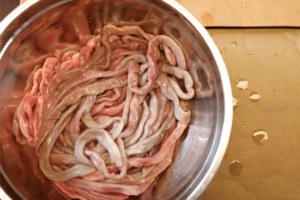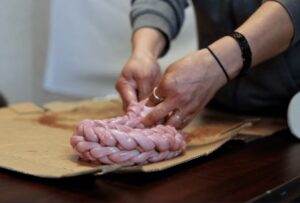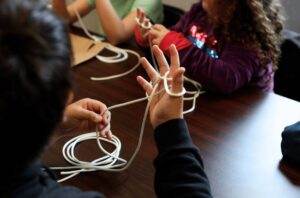Connected featuring Josephine Shangin
 Cats wearing birthday hats, dancers showing off new moves in public, hip-hop mashups of classic movies: this is the stuff that viral videos are made of. But recently, social media gave us something new to look at when Josephine Shangin, from Akutan, Alaska, went live on Facebook to show the world how to braid seal intestine.
Cats wearing birthday hats, dancers showing off new moves in public, hip-hop mashups of classic movies: this is the stuff that viral videos are made of. But recently, social media gave us something new to look at when Josephine Shangin, from Akutan, Alaska, went live on Facebook to show the world how to braid seal intestine.
 “A bunch of friends in Anchorage were like ‘hey go live, I want to watch,’” she says with a laugh.
“A bunch of friends in Anchorage were like ‘hey go live, I want to watch,’” she says with a laugh.
The live stream was a success. Shangin, who has made it part of her life’s work to keep subsistence food traditions alive, says she enjoyed the ability to “share processing traditional foods with those who aren’t in our homelands or able to participate in person. They can participate virtually.”
Shangin grew up in Akutan, and has fond memories from her childhood. “It was fun growing up here,” she explains, “all the freedoms, you know? You’ve heard the saying ‘it takes a village to raise a child’? It was basically that. All of us kids, out from dawn until dusk, picking berries if we’re hungry… all the gathering and harvesting and hunting. It was a great way to grow up here. So I brought my kids back. I wanted them to experience the same thing.”
Shangin learned many traditional subsistence practices from her father and uncle. Her father took her out on the family’s skiff to hunt sea lion, and made her feel helpful by tasking her with spotting the animals in the water. She would point out the location where a sea lion would emerge from the water, honing a skill she continues to use today.
Growing up on Akutan, learning to hunt was like learning to walk. “I can’t tell you my first experience hunting because I don’t remember it,” she says.
Her uncle was also a skilled hunter and, she says, “the last traditional chief.” Though he passed away when Shangin was only five, he was “a great role model” and the lessons he imparted continued to inspire and guide her throughout her life.
As she grew older, life took Shangin away from Akutan. Though she missed her home, the time away was not without its blessings: she met her husband Tim in 1995. After having two sons, Anthony and Ian, the couple decided to move back to Akutan so that the couple’s children could experience the same joyful childhood that Shangin had. Their daughter Emma, who was born shortly after the couple returned, “has only known Akutan.”
“It’s really important to teach my kids how to be able to live off of the land,” she explains, “and have a subsistence lifestyle. You can’t just live off the store. The prices are outrageous. And our food is healthy. It’s basically a store right outside your door, and you can harvest year-round.”
 Back in Akutan, Shangin was thrilled to practice traditional subsistence again. Her father taught Tim to hunt. The children enjoyed fishing and hunting duck, and eating what they harvested. Emma’s favorite traditional food, Shangin says, is seal oil and blubber with dried fish. Shangin enjoys hunting birds, and foraging for wild plants like petruski (wild parsley), putchki (wild celery), and wild rice. Now, the family can provide not only for themselves but for her parents and members of their community.
Back in Akutan, Shangin was thrilled to practice traditional subsistence again. Her father taught Tim to hunt. The children enjoyed fishing and hunting duck, and eating what they harvested. Emma’s favorite traditional food, Shangin says, is seal oil and blubber with dried fish. Shangin enjoys hunting birds, and foraging for wild plants like petruski (wild parsley), putchki (wild celery), and wild rice. Now, the family can provide not only for themselves but for her parents and members of their community.
Shangin’s love for Akutan and its way of life led to her a career serving her community. She served as the President of the Akutan Corporation for four years, after working as Secretary Treasurer for about six. She currently serves as the Executive Director of the Aleut Marine Mammal Commission, a position she has held since 2019.

Despite her leadership roles, Shangin seems happy and comfortable with her sleeves rolled up and her hands filled with slippery, rose-pink seal intestine. She smiles as she teaches a classroom of youngsters from Akutan how to twist the intestine into a thick braid.
“This was a nice little one,” she explains, gesturing toward the intestine, “so it’s not going to take me a half-hour to braid.” The seal was harvested earlier in the week, just across the bay, she says.
Standing at the head of the classroom, she starts by inviting the children to touch the intestine. Some are reluctant, but most do. The children then pick up segments of thin white rope, which they will use to practice the braiding process. Shangin instructs them to hold the “intestine” between their thumbs and forefingers, give it a twist, and then pull it over their pointer fingers. Once one successful looping has been made, the children continue until something like a full braid begins to form. Shangin patiently helps the children one-by-one when they run into problems.

Kids practice braiding on rope.
“Take this one and put it over the top,” she tells one struggling student, pointing to an errant loop. He fixes his braid and continues on his own.
In the back of the classroom, Josy’s husband, Tim, films the scene with a smartphone. It’s a family and subsistence event. Digital documentation and sharing seems an inevitable part of subsistence culture in 2022.
“Are you guys getting it?” she asks the classroom. The students nod quietly. “My Pa’ taught me when I was young,” she says with a smile, “I don’t want to say how long ago.”
Shangin explains that some people pull a fat strip of blubber through the square braid as they go, but she likes to pull it through at the end, after the square braid has already been completed. She likes to create the braid the way her father taught her to do it, she says.
“This is all the flavor here,” she says, referring to the thick strip of fat. “Yumm.” She pushes and pulls the blubber through the middle of the tight braid.
“My Pa, when he taught me, we were on a beach in Akun,” she recalls. They had just harvested a seal, and her father asked her whether she wanted to learn to braid the intestine. When she responded that she did, she was instructed to clean the intestine. It was hard work, but when it was done he sat down with her and taught her how to create the braid. “So that was cool,” she says.
Another child struggles with the braiding. Shangin walks over and helps untangle the mess of rope looped around the child’s hands, and then they continue. The children help each other, and soon the table is covered with rudimentary braids.
Tim moves with his smartphone, a portal to homes around the region, angling the camera toward one of the students and then zooming into the thick, growing braid of seal intestine.
 “Good job!” Shangin tells one student, “Next time I get seal I’m gonna call you down and say ‘clean the seal gut and braid it please!’” The classroom fills with chuckles.
“Good job!” Shangin tells one student, “Next time I get seal I’m gonna call you down and say ‘clean the seal gut and braid it please!’” The classroom fills with chuckles.
Shangin explains that the thick braid of intestine and blubber will be boiled with petruski, putchki, and salt for an hour, and eaten with soy sauce, salt, or seal oil at a community gathering tonight—even though the fat has so much flavor that it can be eaten without seasoning.
She asks the classroom if anyone present has tried seal intestine before. Several children say that they haven’t.
“And that’s it!” she says, laying the braid down on the table. “And there you have it.” The people in the room watching break into applause. Tim leans the phone toward his wife to show her the screen.
By the end of the class, the table is covered in a pile of white rope braids. Though the braids made by the children under Shangin’s instruction today are only made of rope, she hopes that classes like this will lead to the children making the real thing, carrying the food tradition on to the next generation.
Shangin notes that the elders in the community still have a strong affinity for traditional foods. Shangin prepared seal blubber, seal oil, and dried seal meat for the elders last week, she says, and she passes out traditional foods as door prizes at community events. To Shangin, keeping Akutan’s subsistence traditions and enjoyment of subsistence foods active into the next generation is a critical part of preserving Unangax̂ culture.
“The message I’d like to pass on to the younger generation, the next generations,” she says, “is to stay connected. Traditional foods is, in my mind, the closest, most, the best way to stay with your culture, stay with your traditions.”